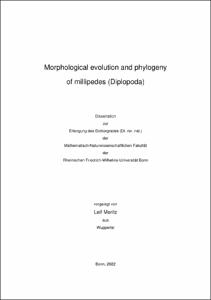Morphological evolution and phylogeny of millipedes (Diplopoda)

Morphological evolution and phylogeny of millipedes (Diplopoda)

| dc.contributor.advisor | Wägele, J. Wolfgang | |
| dc.contributor.author | Moritz, Leif | |
| dc.date.accessioned | 2023-05-25T12:02:30Z | |
| dc.date.available | 2023-05-25T12:02:30Z | |
| dc.date.issued | 25.05.2023 | |
| dc.identifier.uri | https://hdl.handle.net/20.500.11811/10862 | |
| dc.description.abstract | Millipedes (Diplopoda) count more than 12,000 described species and play, probably since more than 400 million years, a fundamental role as detritivores in terrestrial ecosystems. Despite their great diversity and ecological importance, the biology, morphology, and evolution of the group is only poorly understood. This is especially true for the less diverse taxa, like the Colobognatha and Pentazonia, which only received little attention. Furthermore, several character complexes are poorly studied, and there are large gaps within the fossil record of the Diplopoda. Knowledge of these neglected taxa and structures are essential to understand the evolution of the group through time. The studies presented here aim to contribute to our knowledge of the morphological diversity of extant and extinct Diplopoda, and to understand their structure in a functional, ecological, and evolutionary context. Therefore, micro-computed tomography (µCT), synchrotron-µCT (SR-µCT), scanning electron microscopy (SEM), and histology are used to study extant and extinct Diplopoda, and to document the structure of several character complexes, including the feeding apparatus, the Tömösváry organ and the legs.
For the first time it is shown that the colobognathan Polyzoniida, Siphonocryptida and Siphonophorida possess protractible mandibles and a sucking apparatus, similar to that of suctorial insects. The colobognathan Platydesmida show an intermediate state between those fluid-feeding millipedes and the eugnathan biting-chewing mouthpart configuration (chapters 2 & 3). Further variations from this biting-chewing configuration can be seen within the Pentazonia in the giant pill-millipedes (Sphaerotheriida), in which the tentorial complex is modified. These modifications might be related to its ability to roll into a perfect ball (chapter 4). For the pentazonian Glomeridesmida, which have been assumed to closely represent the ground plan of the Chilognatha, a highly derived character is reported for the first time: the presence of a tarsal thread producing ‘spinning’ organ (chapter 5). Not only these little-known taxa yielded novel findings, but it is also demonstrated that characters of comparatively well-known and diverse taxa, like the flat-backed millipedes (Polydesmida) need reexamination. For the Polydesmida it is shown, that a Tömösváry organ is absent, although this character has previously been described for several representatives and is frequently used in taxonomic and phylogenetic studies (chapter 6). Finally, 13 of the 16 extant millipede orders are reported from Cretaceous Burmese amber, including the first or oldest fossil record for half the Diplopoda orders. It becomes evident, that the extant taxa with their highly derived morphologies were already present in the Cretaceous almost 100 million years ago (ma) and only changed little since then (chapters 7 & 8). The presented studies demonstrate how modification of common structures, like the mouthparts, can lead to new functions such as fluid feeding within the primarily biting-chewing Diplopoda. These distinct morphologies were already present almost 100 ma. However, it remains unknown why the ancient and morphological diverse millipedes, and especially the highly derived Colobognatha, show a low species diversity compared to other arthropod taxa like insects and spiders. The data generated here can be used to correct character statements and to contribute new characters to previous phylogenetic analyses, to better understand the evolution of the Diplopoda. However, it becomes clear that more detailed studies of the whole Diplopoda diversity, as well as the restudy of established character systems are needed to fully understand the diversity and evolution of the group. | en |
| dc.language.iso | eng | |
| dc.rights | In Copyright | |
| dc.rights.uri | http://rightsstatements.org/vocab/InC/1.0/ | |
| dc.subject | Doppelfüßer | |
| dc.subject | Tausendfüßer | |
| dc.subject | Morphologie | |
| dc.subject | Anatomie | |
| dc.subject | Millipedes | |
| dc.subject | Moprhology | |
| dc.subject | Anatomy | |
| dc.subject.ddc | 590 Tiere (Zoologie) | |
| dc.title | Morphological evolution and phylogeny of millipedes (Diplopoda) | |
| dc.type | Dissertation oder Habilitation | |
| dc.publisher.name | Universitäts- und Landesbibliothek Bonn | |
| dc.publisher.location | Bonn | |
| dc.rights.accessRights | openAccess | |
| dc.identifier.urn | https://nbn-resolving.org/urn:nbn:de:hbz:5-70951 | |
| dc.relation.doi | https://doi.org/10.1111/ivb.12312 | |
| dc.relation.doi | https://doi.org/10.1126/sciadv.abm0577 | |
| dc.relation.doi | https://doi.org/10.3897/zookeys.741.21909 | |
| dc.relation.doi | https://doi.org/10.3897/asp.79.e70002 | |
| dc.relation.doi | https://doi.org/10.3897/zookeys.930.48438 | |
| dc.relation.doi | https://doi.org/10.15560/14.6.1131 | |
| dc.relation.doi | https://doi.org/10.1007/s13127-019-00408-0 | |
| ulbbn.pubtype | Erstveröffentlichung | |
| ulbbnediss.affiliation.name | Rheinische Friedrich-Wilhelms-Universität Bonn | |
| ulbbnediss.affiliation.location | Bonn | |
| ulbbnediss.thesis.level | Dissertation | |
| ulbbnediss.dissID | 7095 | |
| ulbbnediss.date.accepted | 30.03.2023 | |
| ulbbnediss.institute | Angegliederte Institute, verbundene wissenschaftliche Einrichtungen : Zoologisches Forschungsmuseum Alexander Koenig (ZFMK) | |
| ulbbnediss.fakultaet | Mathematisch-Naturwissenschaftliche Fakultät | |
| dc.contributor.coReferee | Blanke, Alexander | |
| ulbbnediss.contributor.orcid | https://orcid.org/0000-0002-6028-5189 | |
| ulbbnediss.contributor.gnd | 1291242708 |
Dateien zu dieser Ressource
Das Dokument erscheint in:
-
E-Dissertationen (4337)




